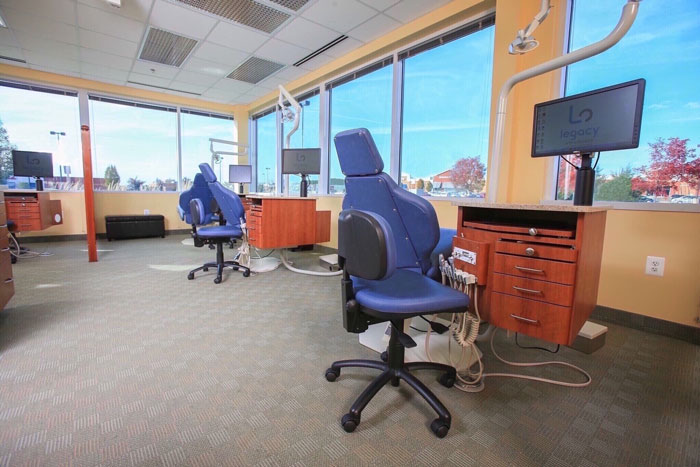How Legacy Orthodontics can Save You Time, Stress, and Money.
Table of ContentsThe Greatest Guide To Legacy Orthodontics8 Easy Facts About Legacy Orthodontics ExplainedThe 10-Minute Rule for Legacy OrthodonticsNot known Factual Statements About Legacy Orthodontics Some Known Incorrect Statements About Legacy Orthodontics
In enhancement, we provide flexible treatment timetables, versatile settlement choices and an enjoyable, enjoyable experience.An orthodontist is a dental expert trained to detect, prevent, and treat teeth and jaw abnormalities. Orthodontists function with people of all ages, from children to grownups.
Malocclusion, or misaligned teeth, can cause dental concerns, including dental cavity, gum disease, and difficult or uncomfortable eating. But not everybody is born with straight teeth. If you have a negative bite or large areas in between your teeth, you might wish to speak with a dentist concentrating on orthodontic treatment.
Little Known Questions About Legacy Orthodontics.
( Picture Credit: DigitalVision/Getty Images) Orthodontists make use of dealt with and removable oral tools, like dental braces, retainers, and bands, to change the setting of teeth in your mouth. Orthodontic therapy is for dental problems, consisting of: Uneven teethBite problems, like an overbite or an underbiteCrowded teeth or teeth that are too far apartJaw misalignmentThe goal of orthodontic therapy is to improve your bite.
A healthy bite ensures you can consume, eat, and talk properly. While you might think about orthodontists as mostly for kids or teens that require braces, they can deal with oral troubles at any kind of age. Orthodontists participate in university, oral school, and orthodontic school. After college graduation, they spend 2 or 3 years in an orthodontic residency program.
All orthodontists are dental experts, however not all dental practitioners are orthodontists. Orthodontic residency programs provide extensive, concentrated guideline for oral professionals. They focus on 2 areas: Just how to correctly and securely relocate teeth How to effectively assist development in the teeth, jaw, and faceOnce an orthodontist has actually finished training, they have the choice to become board accredited.
Some Ideas on Legacy Orthodontics You Should Know
Misalignment, or malocclusion, is one of the most typical reason people see an orthodontist. It is genetic and is the result of dimension distinctions in between the top and lower jaw or in between the jaw and teeth. Malocclusion brings about tooth overcrowding, a twisted jaw, or irregular bite patterns. Malocclusion is normally treated with: Your orthodontist connects steel, ceramic, or plastic square bonds to your teeth.
If you have only small malocclusion, you may be able to use clear dental braces, called aligners, rather than traditional braces (https://www.kickstarter.com/profile/legacyortho/about). Some people need a headgear to assist move teeth right into line with pressure from outside the mouth. After braces or aligners, you'll need to put on a retainer. A retainer is a custom gadget that keeps your teeth in area.
They're frequently used on youngsters. They can create added room in the mouth without needing to pull teeth. If you have a significant underbite or overbite, you may need orthognathic surgical treatment (likewise called orthodontic surgery) to extend or reduce your jaw. Orthodontists use wires, medical screws, or plates to support your jaw bone.
You may need to see an orthodontist if you have: Crowding or not sufficient space for all of your teethOverbite, when your upper teeth come over your base teethUnderbite, when your bottom teeth are too much forwardSpacing or concerns with gapsCrossbite, which is when your upper teeth fit behind your base teeth when your mouth is closedOpen bite or a vertical void in between your front base and upper teethMisplaced midline, when the facility of your base and top teeth don't align Correcting an oral malocclusion can: Make biting, chewing, and speaking easierImprove the balance of our face and your overall appearanceEase pain from temporomandibular joint disordersSeparate your teeth and make them easier to clean, helping stop dental cavity or dental caries It's typically a dental practitioner that first notices misaligned teeth throughout a routine examination.
Some Ideas on Legacy Orthodontics You Should Know

During your first orthodontic consultation, you'll likely have: A dental examPhotos taken of your face and smileDental X-raysPanoramic (360 degree) X-rays of your face and headImpressions to produce mold and mildews of your teethThese examinations will certainly help great post to read your orthodontist understand how to wage your treatment. leesburg orthodontics. An orthodontist is a dental practitioner who's had training to treat your teeth and jaw
Orthodontists may carry out surgical treatment, exams,X-rays,and more to help you obtain a much more comfortable, much healthier smile. An orthodontist is concentrated on your bite, so something like a chipped tooth would certainly be taken care of by a dental professional. Orthodontists are dental practitioners however not all dental experts are orthodontists. Orthodontists are focused on your bite, or the means your teeth fit together, and the straightness of your teeth.
Ever before questioned just how celebs always appear to have perfectly aligned teeth? The response usually hinges on the competent hands of an orthodontist. What exactly does an orthodontist do? Orthodontists are dental experts that concentrate on dealing with abnormalities in the teeth and jaws. Their experience surpasses just producing an attractive smile; it includes boosting your general oral wellness and function.
Not known Details About Legacy Orthodontics

, orthodontists have a varied toolkit at their disposal. These tried-and-true braces use a system of braces adhered to the teeth and connected by cables.
Clear aligners, like Invisalign, are a preferred choice for individuals seeking a much more very discreet therapy alternative. These detachable trays are customized to gradually shift the teeth's placement. Headgear might be made use of along with braces or aligners to use added targeted forces, specifically for dealing with jaw inconsistencies. In situations of slim jaws, palatal expanders can be used to produce space for proper tooth placement.